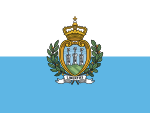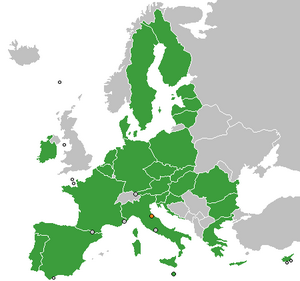San Marino and the European Union

|

|
|

|
||
|
|
||
The Republic of San Marino is not a member of the European Union . San Marino is closely linked to the EU both economically and politically and culturally . Official relations between San Marino and the then European Communities have existed since February 1983.
Agreement on EU-San Marino cooperation and customs union
The agreement between San Marino and the EU on the creation of a customs union and further cooperation was signed in Brussels in 1991. It came into force on April 1, 2002.
In addition to a common external tariff vis-à-vis third countries, the agreement guarantees mutual freedom from customs duties and equal treatment of employees. In principle, workers are treated equally in San Marino and in the EU member states. They enjoy protection from discrimination.
In addition, both sides agreed to strengthen cooperation in the areas of environment, culture and academic exchange as well as the implementation of Union law in the areas of animal welfare, plant protection, quality control, customs and agricultural products.
The agreement has set up an EU-San Marino cooperation committee to monitor its application and resolve disputes.
San Marino is currently interested in extending the scope of the agreement.
On July 1, 2009, San Marino acceded to the European Patent Convention . In this way, patent protection can be obtained in San Marino via a European patent. A European community trademark is not valid in San Marino, however, as community trademarks are only valid for EU member states.
Euro
San Marino has been linked to Italy in a monetary union since 1862. Up until the introduction of the euro, the Italian lira was the official currency together with the San Marinese lira . San Marino introduced the euro as its official currency on January 1st, 2002 on the basis of a currency agreement negotiated by Italy with the EU. The EU has granted the country the right to put its own euro coins into circulation, which are recognized as valid currency in the entire euro area. San Marino is allowed to put euro coins into circulation up to a nominal value of 1.944 million euros annually. These are deducted from the Italian part of the euro.
In addition, San Marino retains the right to mint its own collector's coins . However, the gold coins denominated in Scudi are not recognized as means of payment in the euro area.
In November 2009 the EU decided that in future the European Court of Justice should serve as an arbitration body for disputes between the euro zone and San Marino. Euro countries could be subject to EU sanctions for violating the rules for the common currency. In the case of states like the Vatican and San Marino, on the other hand, according to the applicable agreements, there is no influence in the event of violations.
Taxes
On March 16, 2005, an agreement with the EU on the taxation of income from savings of non-residents in San Marino entered into force. Nevertheless, San Marino is still regarded as a low-tax country, even if bilateral agreements with Italy prevent overly liberal tax and financial policies.
In the fight against tax fraud, the EU is currently in talks with San Marino on the conclusion of an anti-fraud agreement. San Marino is committed to supporting the Europe-wide application of OECD standards to combat tax fraud.
Schengen
San Marino is not subject to the Schengen Agreement . However, traditionally there are no border controls with the only neighboring country, Italy . Schengen visas are recognized for entry into San Marino.
outlook
The San Marino government is currently not actively pursuing the question of an application to join the EU. Membership in the European Economic Area (EEA), to which Liechtenstein , Iceland and Norway also belong in addition to the EU member states , does not rule out San Marino in the medium term. Prior membership in the EFTA would be a prerequisite for admission to the EEA .
After a more isolationist policy had been a priority for San Marino for centuries, interest in working in international organizations has increased since joining the Council of Europe (1988) and the United Nations (1992).
However, a referendum on EU accession on October 20, 2013 failed due to insufficient participation.
Individual evidence
- ↑ List of non-EU countries European Commission, accessed on February 16, 2017
- ↑ http://eeas.europa.eu/archives/docs/sanmarino/docs/aidememoire_en.pdf
- ↑ http://eur-lex.europa.eu/legal-content/DE/TXT/PDF/?uri=uriserv:OJ.C_.2001.209.01.0001.01.DEU
- ↑ Schengen Agreement. Federal Foreign Office, September 29, 2009, accessed March 22, 2011 .
- ↑ http://www.esteri.sm/on-line/en/Home/News/articolo1000972.html